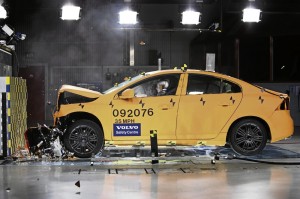Volvo S60, Acura TL garner top ratings in severe offset crash test
Only two midsize luxury cars earned a “good” rating in a new severe crash test instituted by the US Insurance Institute for Highway Safety (IIHS)—the Acura TL and Volvo S60. The Infiniti G earned an acceptable rating; the Acura TSX, BMW 3 Series, Lincoln MKZ and Volkswagen CC earned marginal ratings; while the Mercedes-Benz C-Class, Lexus IS 250/350, Audi A4, and Lexus ES 350 earned a poor rating. All are 2012 models. The ratings are an indication of how well they protect a driver in a certain type of crash.
IIHS describes itself as “an independent, nonprofit research and communications organization funded by auto insurers and dedicated to reducing highway crash deaths, injuries, and property damage.” It is reputed to have developed more stringent crash tests than its US government agency counterpart. It tests vehicles and their safety accessories like infant seats.
The new IIHS test involves crashing the test vehicle into a 1524-mm-tall rigid barrier at 64 kph. Only 25 percent of the car’s front end strikes the barrier, increasing the probability of deformation and stress on the car’s chassis. A 50th percentile male Hybrid III dummy is buckled up in the driver’s seat. The test is meant to simulate the front corner of a car colliding with another vehicle or a fixed object like a tree or utility pole. The test is reportedly not conducted anywhere else in the United States or Europe, apart from some automakers’ proving grounds.
A strong safety cage is the key to protecting the occupants—in this case the test dummy. While most cars are designed to withstand heads-on collisions and what the institute calls moderate overlap frontal crashes, where at least 40 percent of the vehicle’s front is exposed to the crash barrier. The small overlap crash test more severely tests the car’s safety cage, as it hits the vehicle’s corner or outer edge. The energy impacts the front wheel, suspension system, and firewall. If these parts intrude into the passenger footwell, the driver will be seriously injured.
The cars with lower ratings saw lots of intrusion into the driver’s compartment, and some had the crash test dummy missing the airbag.
In contrast, the Volvo S60’s safety cage did almost as well in the severe test as in the moderate overlap test. IIHS noted that the S60 had reinforced upper rails and a steel cross member below the instrument panel, which helped keep the safety cage impact. The Lexus IS had up to 10 times the occupant compartment intrusion as the Volvo. The footwell was collapsed by the left front wheel, which was pushed rearward, trapping the dummy’s left foot. The Mercedes C-Class, too, saw the dummy’s right foot trapped under the brake pedal. The VW CC even had its driver door sheared off its hinges, a dubious honor of being the first car to completely lose its door in an IIHS test. The Audi A4’s door opened but remained attached.
The Acura TSX, BMW 3 Series, Lincoln MKZ, VW CC, Audi A4, and Mercedes C-Class previously garnered a “Top Safety Pick” award from the IIHS based on a moderate-overlap front, side, rollover, and rear crash tests. However, the new test is meant to replicate real-world frontal crashes. IIHS president Adrian Lund says that while nearly every new car performs well in other frontal crash tests, “we think this is the next step in improving frontal crash protection.”
It’s worth noting that Honda (Acura is Honda’s luxury brand) and Volvo are the only two companies with facilities to conduct crash tests on two actual vehicles (rather than using barriers or simulators). Such obsession with safety research does pay off. Next, the IIHS will conduct the severe offset test on more affordable midsize sedans.

